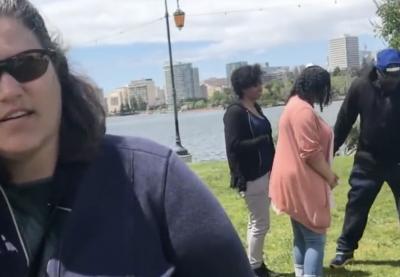It’s an image so iconic that Norman Rockwell penciled it onto paper: the enterprising child selling lemonade on a hot day, go-getter capitalist intuition and neighborly compassion all in one. A source of relief, a sign of ambition, a hallmark of summer.
But alter the details ever so slightly and the story—for some—turns sinister. Replace a bucolic setting with a San Francisco street. Swap out the white children selling lemonade with an 8-year-old black girl selling water. And watch as a symbol of Americana becomes, for one white woman at least, cause for a 911 call. Caught on camera last week, the call inspired the viral hashtag #PermitPatty and served as the latest reminder that racial bias remains an obstacle for black people trying to simply exist.
In 2018, we’ve seen people call the cops for several “crimes”: barbecuing while black, sitting at Starbucks while black, napping in a dorm common room while black, leaving an Airbnb with one’s own luggage while black, moving into one’s own apartment while black, and mowing while black. Let’s be clear: These incidents of bias are not just inconveniences. These 911 calls—borne of bias—are a depressingly common form of social control. These calls are psychologically and physically damaging. And, given that black people are disproportionately more likely to be assaulted or killed by law enforcement while unarmed or not attacking, these calls are threats.
The supposedly well-meaning white women behind these viral 911 calls may not have intended to inflict these consequences on the black people they endangered. But if we’re going to ask students to hold themselves accountable for the impact of their choices and the intent behind them, we should hold our colleagues and ourselves to the same standard. And that may mean facing some uncomfortable truths about how unconscious bias shapes interactions in the classroom, as well as on the streets.
We know that teachers subconsciously hone in on black boys when looking for “challenging behavior.” And black boys and girls are disciplined at much higher rates starting as early as preschool. We know white teachers are much more likely than their black colleagues to see a black student’s behavior as problematic. Researchers who analyze the data almost all come to the same conclusion: This isn’t the result of black children misbehaving more often or more severely.
The scene plays out like this: A teacher extends the benefit of the doubt to a white child who interrupts class with a verbal outburst. That child is waved off; perhaps the teacher laughs. If it’s a “gifted” child, the interruption stems from being bored by the content. Perhaps it’s just their personality. But when a black student does the same thing, it’s seen as an act of disrespectful defiance. The teacher reprimands them or moves them down on the behavior chart. Perhaps the teacher threatens their privileges. Rarely does the teacher propose that this student is bored because they are gifted, or because the coursework isn’t relevant to them.
It’s the result of implicit bias, the same bias that leads predominantly white groups of adults to see black boys and black girls as older and less innocent than their white classmates.
When teachers act on these biases, following the same impulse that led to the 911 calls, they endanger their students. This is especially true in schools with “zero-tolerance” policies. As this series of charts shows, black students are expelled and suspended at higher rates than white students. And they are much more likely to be arrested in school. Black children with disabilities are disproportionately more likely to be physically restrained or isolated; 1 in 4 are suspended at least once. Suspended students are more likely to end up in juvenile detention facilities, which often fail to protect them from violence and abuse. Students incarcerated as juveniles are much less likely to complete high school, and often enter a cycle of arrests and dealings with the criminal justice system.
And unfortunately, viral videos offer plenty of evidence of this bias in schools. Time and time again, we’ve witnessed black students fall victim to physical harm by police and school resource officers. In Louisville, Kentucky; in Columbia, South Carolina; in Baltimore and Pittsburgh, students faced dangerous interactions. The recent death of 17-year-old Antwon Rose at the hands of police brought to light an ongoing lawsuit against his high school, alleging that police stationed there regularly abuse students physically and verbally.
Reversing these trends will require a sea change. But teachers, and especially white teachers, can begin with honest self-reflection. Consider the following questions.
Are my biases and assumptions informing my practice?
Don’t answer too quickly—biases are often more powerful than intentions. Ask yourself:
- Do I make assumptions about certain student behaviors?
- If I see a colleague treating students of color unfairly, do I speak up?
And check in with yourself. Test yourself for hidden biases. Consider ways you can address those biases in the future. Biases are only implicit until you recognize them. Recognition is the first step toward change.
Am I dialing 911 on my students when I could show compassion?
Consider your approach to classroom management, and investigate your school’s record of disciplining students of color. Ask yourself:
- Are my practices trauma-responsive?
- How often do students at my school get suspended and expelled? For what offenses? Are students of color more likely to miss school for less extreme behavior?
Plan an audit of your disciplinary practice. Record your class or ask an observer to keep track of which actions you address and which you don’t—and which students are doing the acting. Use our Code of Conduct guide to role play scenarios and discover more responsive solutions.
Before you can effectively respond to the behavior of your students, you must first take ownership of your own. If more educators don’t, that’s the emergency.
Collins is the senior writer for Teaching Tolerance.
